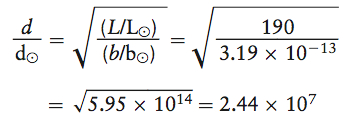Answers
ConceptChecks
ConceptCheck 17-1: A very nearby flashlight will appear much brighter than a very distant spotlight. Although a large spotlight emits more light than a small flashlight, the light that appears brighter depends on their distances away.
ConceptCheck 17-2: The parallax angle is smallest for the most distant stars, so if a parallax angle was measured to be too small, then the astronomer would assume the star is farther away than it actually is.
ConceptCheck 17-3: Parallax only works for stars that are relatively nearby, and the majority of stars in our Galaxy are much too far away to exhibit any apparent shift in position as Earth orbits the Sun.
ConceptCheck 17-4: Because a star’s apparent magnitude when viewed from a distance of 10 pc is the same as its absolute magnitude, both magnitudes would be the same, +4.8.
ConceptCheck 17-5: From Earth, Tau Ceti appears to be relatively bright at +3. However, if it were viewed from a distance of 10 pc, it would appear much dimmer, at +6. The only way this can be is if Tau Ceti is much closer to Earth than 10 pc.
ConceptCheck 17-6: The shorter the peak wavelength, the higher the temperature. The blue star emits light that peaks at blue wavelengths, and these are shorter wavelengths than the other star’s peak at orange wavelengths. Thus, the blue star is hotter. (Figure 17-7 illustrates these effects.)
ConceptCheck 17-7: The prominence of certain hydrogen absorption lines visible in the star, with A class being the greatest and O class being the least.
ConceptCheck 17-8: In the sequence OBAFGKM, F-spectral class stars with designations F1, F2, F3, and F4 are more similar to A-spectral class stars, and F6, F7, F8, and F9 are more similar to G-spectral class stars.
ConceptCheck 17-9: No. Within a particular spectral class, the larger numbers correspond to cooler stars. For example, a G2 star is hotter than a G8 star because a G2 is closer to the hotter F-spectral class stars in the sequence OBAFGKM.
ConceptCheck 17-10: Given that the modern spectral sequence of stars and brown dwarfs from hottest to coolest is OBAFGKMLT, L-spectral class brown dwarfs are hotter than T-spectral class brown dwarfs.
ConceptCheck 17-11: Stars like our Sun derive their energy from nuclear reactions in the core, whereas brown dwarfs derive their energy from gravitational contraction. Brown dwarfs are not true stars.
ConceptCheck 17-12: A bonfire often extends over a large area so that it has an enormously high luminosity, even at the same temperature of a match or a handheld lighter.
ConceptCheck 17-13: The H-R diagram is plotted as increasing luminosity on the vertical axis and decreasing temperature along the horizontal axis. The stars with the greatest luminosity and the highest temperatures are found in the upper left-hand corner of the H-R diagram.
ConceptCheck 17-14: You can read from the vertical axis of the H-R diagram that Betelgeuse is much more luminous than Barnard’s star. Since they both have similar surface temperatures (around 3500 K), Betelgeuse must be much larger to emit its larger luminosity.
ConceptCheck 17-15: Regulus. All main-sequence stars, and only these stars (such as Regulus, but not Mira), convert hydrogen to helium in their cores.
ConceptCheck 17-16: The main sequence and all its stars have luminosity class V. At higher temperatures, the main-sequence stars can have a greater luminosity than the lower-temperature stars in luminosity class III.
ConceptCheck 17-17: Main-sequence stars are luminosity class “V” whereas luminosity class “II” are giant stars. In this instance, the two stars have the same temperature because they are in the same spectral class, but the luminosity class II star is larger and has a greater luminosity than the much smaller main-sequence star.
ConceptCheck 17-18: If two stars orbiting a common center of mass were moved farther apart, their masses would not change, but the period would increase following Kepler’s third law.
ConceptCheck 17-19: According to the mass-luminosity relation, the most luminous main-sequence stars are also the most massive, have the largest radii, and have the greatest temperatures.
ConceptCheck 17-20: At Stage 2, neither of the stars moves toward or away from Earth. The only radial velocity Doppler shift arises from the pair of stars as they drift together through space, which in this case, can be read near the bottom of Figure 17-23 for Stage 2 at about +12 km/s away from Earth. Since both stars have this same radial velocity at Stage 2, their absorption lines are not split.
ConceptCheck 17-21: When the bright white dwarf passes behind the larger and dimmer star, the light coming from the dimmer star is still visible.
CalculationChecks
CalculationCheck 17-1: Given that distance in parsecs is the inverse of the parallax angle, d = 1/0.7772, then d = 1.35 pc. Because 1 pc is 3.26 ly, we find that 1.35 pc × (3.26 ly/1pc) = 4.4 ly.
CalculationCheck 17-2: According to the inverse-square law nature of light, the intensity of the light received decreases with the square of the distance. In this instance, increasing the distance 3 times means the newspaper receives only 1/(3)2 or one-ninth the amount of light it originally received.
CalculationCheck 17-3: Pleione’s luminosity relative to that of the Sun is L/L⊙ = 190. The ratio of their apparent brightnesses is b/b⊙ = 3.19 × 10−13. Rearranging the equation relating luminosity, distance, and brightness yields the distance from Earth to Pleione as 2.44 × 107 times greater than the distance from Earth to the Sun:

CalculationCheck 17-4: If luminosity is given by the Stefan-Boltzmann law where L = 4πR2σT4, then if radius, R, is tripled, then L must increase by the R2, which is, in this instance, 32 or 9 times, for a star 3 times larger but at the same temperature.